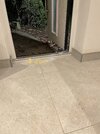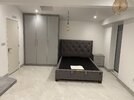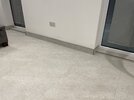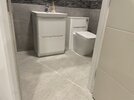Hi everyone
12 months ago we got a builder to do a detached double garage conversion into a studio annex. He quoted 2 months and took 12 months, and that was after I had to intervene and tell him how to do a lot of the building work by having a chat with the building regs man who was overseeing things.
Anyways, finally kicked the builder out of our property, and most things are ok. However, I had to do the electric underfloor heating myself. Laid it directly on the new 50mm screed WITHOUT laying any insulation on top of the screed (I know, I don’t know how this slipped my mind). I thought it would be ok because of the insulation under the screed (builder laid 50mm kingspan type on the bare ground before the 50-60mm screed)
Tiler came and he also thought it would be ok. He put a layer of latex levelling over the heated mats, then laid the tiles with flexible adhesive. Now its come to trying out the heating and it takes HOURS and HOURS to even get just the chill off the tiles, never mind heating up the room. What a disaster! The mats are definitely all working fine as I did the multi meter test before, during and after installation, its all good.
Now I had a chat with the tiler and he has suggested that I start from scratch ON TOP of the existing tiling: lay the insulation, then mats, then latex (optional), then the tiles again with flexible adhesive. Problem is, now the fitted wardrobe and full kitchen has been installed, and the toilet and basin unit too.
I’ve had a look at the main door sill (see photos) and the shower tray height from the tiles and determined that I have about 40mm to play with. The tiles with adhesive will be around 10-12mm. What would be the best course of action?
As you can see from the photos, I’m mega annoyed as the garage conversion otherwise looks pretty good. But this flooring is a major disaster…
Any advice much appreciated…
12 months ago we got a builder to do a detached double garage conversion into a studio annex. He quoted 2 months and took 12 months, and that was after I had to intervene and tell him how to do a lot of the building work by having a chat with the building regs man who was overseeing things.
Anyways, finally kicked the builder out of our property, and most things are ok. However, I had to do the electric underfloor heating myself. Laid it directly on the new 50mm screed WITHOUT laying any insulation on top of the screed (I know, I don’t know how this slipped my mind). I thought it would be ok because of the insulation under the screed (builder laid 50mm kingspan type on the bare ground before the 50-60mm screed)
Tiler came and he also thought it would be ok. He put a layer of latex levelling over the heated mats, then laid the tiles with flexible adhesive. Now its come to trying out the heating and it takes HOURS and HOURS to even get just the chill off the tiles, never mind heating up the room. What a disaster! The mats are definitely all working fine as I did the multi meter test before, during and after installation, its all good.
Now I had a chat with the tiler and he has suggested that I start from scratch ON TOP of the existing tiling: lay the insulation, then mats, then latex (optional), then the tiles again with flexible adhesive. Problem is, now the fitted wardrobe and full kitchen has been installed, and the toilet and basin unit too.
I’ve had a look at the main door sill (see photos) and the shower tray height from the tiles and determined that I have about 40mm to play with. The tiles with adhesive will be around 10-12mm. What would be the best course of action?
As you can see from the photos, I’m mega annoyed as the garage conversion otherwise looks pretty good. But this flooring is a major disaster…
Any advice much appreciated…
Attachments
-
 4BA3FD65-EC71-4EE2-906F-0FB3E8F8D9FC.jpeg449.7 KB · Views: 86
4BA3FD65-EC71-4EE2-906F-0FB3E8F8D9FC.jpeg449.7 KB · Views: 86 -
 C5747233-6BB3-497F-9995-962812194415.jpeg231.1 KB · Views: 88
C5747233-6BB3-497F-9995-962812194415.jpeg231.1 KB · Views: 88 -
 6E399776-9E45-4B8F-8632-7F7316A1F051.jpeg260.1 KB · Views: 91
6E399776-9E45-4B8F-8632-7F7316A1F051.jpeg260.1 KB · Views: 91 -
 89319FBA-6CFD-4045-ABF9-62F59D545BBA.jpeg333.6 KB · Views: 86
89319FBA-6CFD-4045-ABF9-62F59D545BBA.jpeg333.6 KB · Views: 86 -
 E4C20B1D-7032-4ABF-8BE0-333F1FEECCA9.jpeg269.1 KB · Views: 79
E4C20B1D-7032-4ABF-8BE0-333F1FEECCA9.jpeg269.1 KB · Views: 79 -
 0705224A-83F3-4F26-92C3-CD9EEB3ECF9C.jpeg296.4 KB · Views: 88
0705224A-83F3-4F26-92C3-CD9EEB3ECF9C.jpeg296.4 KB · Views: 88


